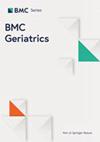The frail-LESS (LEss sitting and sarcopenia in frail older adults) remote intervention to improve sarcopenia and maintain independent living via reductions in sedentary behaviour: findings from a randomised controlled feasibility trial
IF 3.4
2区 医学
Q2 GERIATRICS & GERONTOLOGY
引用次数: 0
Abstract
Sarcopenia leads to functional disability, dependence in activities of daily living (ADL), and is a key contributor to frailty. Reducing and breaking up sedentary time is associated with improved sarcopenia and frailty-related outcomes. The aim of this study was to determine the feasibility of delivering and evaluating a remote sedentary behaviour intervention to improve sarcopenia and independent living in older adults with frailty. A two-arm randomised controlled feasibility trial was conducted with a target of 60 older adults (mean age 74 ± 6 years) with very mild or mild frailty. Participants were randomised to the Frail-LESS (LEss Sitting and Sarcopenia in Frail older adults) intervention or usual care control group for six months. The intervention included tailored feedback on sitting, standing and stepping; an education workbook that included goal setting and action planning; one-to-one health coaching; peer support; and a wearable device to self-monitor sedentary behaviour. Participant recruitment (percentage of eligible individuals recruited), retention and data completion rates were used to assess trial feasibility. Acceptability of the trial was explored through interviews and safety was evaluated via unplanned healthcare utilisation and number of falls. Sitting, standing, stepping and sarcopenia were measured to evaluate potential intervention effects. Sixty participants were recruited. Recruitment and retention rates were 72% and 83%, respectively. Completion rates for outcome measures ranged from 70 to 100%. The trial was safe (< 1 fall per participant on average at each timepoint) and trial procedures were acceptable. Descriptive analysis (mean ± SD) showed that daily sitting was 25.1 ± 82.1 min/day lower in the intervention group, and 6.4 ± 60.5 min/day higher in the control group, at 6 months compared with baseline. Hand grip strength and sit-to-stand score were improved by 1.3 ± 2.4 kg and 0.7 ± 1.0, respectively, in the intervention group. This study demonstrates the feasibility and safety of delivering and evaluating a remote intervention to reduce and break up sitting in older adults with frailty. The intervention showed evidence towards reducing daily sitting and improving sarcopenia, supporting its evaluation in a definitive randomised controlled trial. ISRCTN registry (registration number: ISRCTN17158017). Registered 6th August 2021.通过减少久坐行为来改善肌肉疏松症并保持独立生活的远程干预措施 frail-LESS(LEss 久坐与体弱老年人肌肉疏松症):随机对照可行性试验的结果
肌肉疏松症会导致功能性残疾和日常生活活动(ADL)依赖性,也是造成虚弱的一个关键因素。减少和缩短久坐时间与改善肌肉疏松症和虚弱相关的结果有关。本研究旨在确定实施和评估远程久坐行为干预的可行性,以改善患有虚弱症的老年人的肌肉疏松症和独立生活能力。本研究以 60 名患有轻度或中度虚弱症的老年人(平均年龄为 74 ± 6 岁)为对象,开展了一项双臂随机对照可行性试验。参与者被随机分配到 "Frail-LESS"(LEss Sitting and Sarcopenia in Frail older adults)干预组或常规护理对照组,为期 6 个月。干预措施包括对坐姿、站姿和迈步的定制反馈;教育工作手册,其中包括目标设定和行动规划;一对一健康指导;同伴支持;以及用于自我监测久坐行为的可穿戴设备。通过参与者招募率(符合条件者的百分比)、保留率和数据完成率来评估试验的可行性。通过访谈探讨了试验的可接受性,并通过非计划医疗使用率和跌倒次数评估了试验的安全性。对坐姿、站姿、步态和肌肉疏松症进行了测量,以评估潜在的干预效果。共招募了 60 名参与者。招募率和保留率分别为 72% 和 83%。结果测量的完成率从 70% 到 100% 不等。试验是安全的(每个时间点平均每位参与者摔倒的次数小于 1 次),试验程序也是可以接受的。描述性分析(平均值±标度)显示,与基线值相比,干预组在6个月时每天的坐姿降低了25.1±82.1分钟,对照组每天的坐姿提高了6.4±60.5分钟。干预组的手部握力和坐立评分分别提高了 1.3 ± 2.4 公斤和 0.7 ± 1.0 分。这项研究证明了对体弱老年人进行远程干预以减少和打破久坐状态的可行性和安全性。有证据表明,该干预措施可减少日常久坐并改善肌肉疏松症,支持在明确的随机对照试验中对其进行评估。ISRCTN 注册(注册号:ISRCTN17158017)。2021 年 8 月 6 日注册。
本文章由计算机程序翻译,如有差异,请以英文原文为准。
求助全文
约1分钟内获得全文
求助全文
来源期刊

BMC Geriatrics
GERIATRICS & GERONTOLOGY-
CiteScore
5.70
自引率
7.30%
发文量
873
审稿时长
20 weeks
期刊介绍:
BMC Geriatrics is an open access journal publishing original peer-reviewed research articles in all aspects of the health and healthcare of older people, including the effects of healthcare systems and policies. The journal also welcomes research focused on the aging process, including cellular, genetic, and physiological processes and cognitive modifications.
文献相关原料
| 公司名称 | 产品信息 | 采购帮参考价格 |
|---|
 求助内容:
求助内容: 应助结果提醒方式:
应助结果提醒方式:


